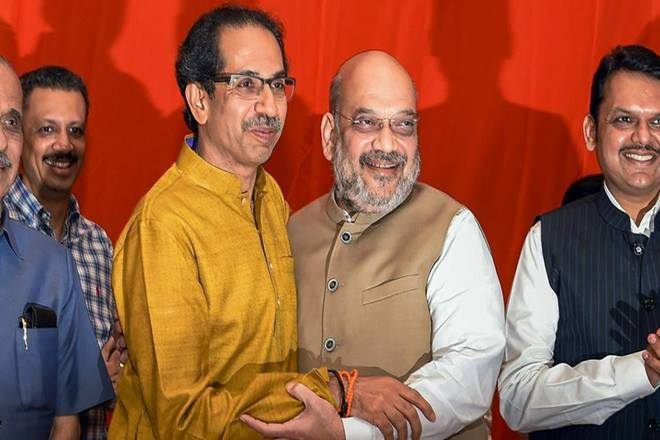The ruling BJP-Shiv Sena alliance returned to power in Maharashtra on Thursday, winning 161 of the 288 seats in the state Assembly. But the poll outcome is a major setback for the BJP which could win 105 seats, way below its ambitious target of crossing the 144 half-way mark on its own, and 17 less than its strength of 122 members in the previous House.
As the results came in, chief minister Devendra Fadnavis conceded his party’s failure to contain “rebels” which, he said, held back the BJP from reaching its target. As many as 30 rebels (of the BJP-Sena) have adversely affected the party’s fortunes. He, however, said the people gave the BJP-Sena a decisive mandate to form the government for a second consecutive term.
The pushback by Maratha strongman Sharad Pawar, despite action by enforcement agencies against him and colleague Praful Patel, in the last days of the poll campaign secured 54 seats for NCP, a gain of 13 seats over its 2014 tally. Its alliance partner Congress, notwithstanding a lacklustre campaign, also bagged 44 seats, two more than its 2014 count.

Together, they touched the three-digit figure of 100, lending the Opposition more voice in the Assembly. During the day, when it looked certain that the BJP-Sena alliance would return to power, Fadnavis held talks with Sena president Uddhav Thackeray. The Sena, on its own, could win only 56 seats, a loss of seven seats compared with the 2014 polls. Nevertheless, the Sena asserted itself and sought a 50:50 power-sharing formula.
“We understood the BJP’s problems and yielded more seats during ticket distribution. All senior leaders of both parties will sit together now, and take a decision on power sharing. Then only we will stake claim to form the government,” Thackeray said to a question on who will head the new government. In the same breath, he ruled out any truck with NCP-Congress. “I will not do anything out of turn,” he said.
For the Sena though, the low tally was a disappointment. The elections marked the electoral debut of young Aditya Thackeray, who won the Worli seat in Mumbai with a margin of 67,427 votes.
The BJP-led alliance’s poor performance is attributed to the aggressive campaign of Pawar who took head on the central and state leadership of the BJP. This helped NCP retain its sway over western Maharashtra. In fact, Pawar-play also salvaged the situation for the Congress which appeared leaderless throughout the campaign.
Although the BJP has kept its analysis on hold for now, the results show that the party took a beating across Vidarbha and Marathwada, regions gripped by the agrarian crisis, besides western Maharashtra.
In cotton-growing Vidarbha where it had peaked with 44 of the 62 seats, it lost nine. Similarly, in western Maharashtra where the BJP had won 25 of the 72 seats, it surrendered nine. The number of seats lost in north Maharashtra and Marathwada were relatively lower at three.
Notwithstanding the loss of seats, Fadnavis put up a brave front and declared it was time for celebration. Justifying the performance, he said, “In 2014, the party contested 260 seats and won 122 seats. Whereas, now it contested 164 seats and won 102 seats.” In the past, the “strike rate” was 47% and the vote share 28%. The “strike rate” has seen a quantum jump of 70% and the vote share 26.5%, approximately.


